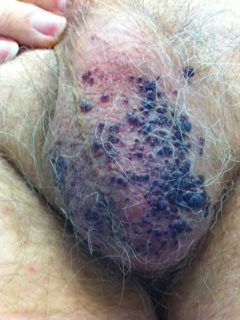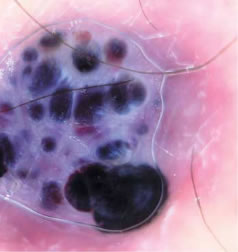ANGIOKERATOMAS OF THE SCROTUM
Luciano Schiazza M.D.
Dermatologist
c/o InMedica - Centro Medico Polispecialistico
Largo XII Ottobre 62
cell 335.655.97.70 - office 010 5701818
www.lucianoschiazza.it
Angiokeratomas of the scrotum (also known as angiokeratomas of Fordyce, from the name of the American dermatologist who first described it in 1896) are asymptomatic red-to-blue-to black dome-shaped papules with a scaly surface, 1 to 5-6 mm, located on the scrotum. Other possible sites are shaft of penis, inner thigh, lower abdomen.

The morbidity of these benign lesions comes from bleeding or anxiety following the detection of the lesions.
Bleeding (spontaneous, during intercourse, traumatized after shower) may be the first presentation causing the patient to seek medical help.
Etiopathology of angiokeratomas is uncertain. Increased venous pressure (varicocele, hernias, epididymal tumors, utinary system tumors, trauma, thrombophlebitis) may contribute to their formation but many are the cases not associated with this cause.
Angiokeratomas occur at any ages but were most prevalent among people older the 40 years.

Dermatoscopy shows round-to-oval, red-to-black, lacunar areas with a whitish veil.
Excluded conditions of increased venous pressure, the patient can be reassured about the lesions’ benign nature. If lesions bleed, several treatment options are available:
- cryotherapy with liquid nitrogen
- electrocautery
- laser
Patients with multiple angiokeratomas are more likely to have recurrence after treatment.
Angiokeratomas of the scrotum are common, benign lesions and does not represent any form of sexually transmitted disease.
